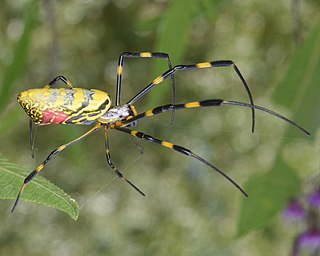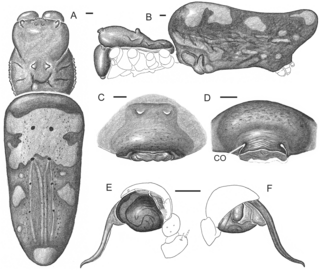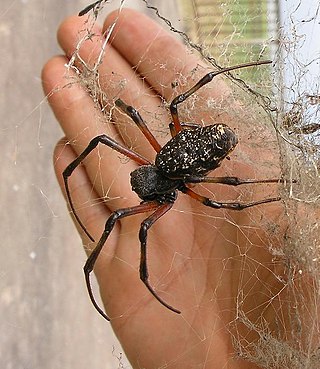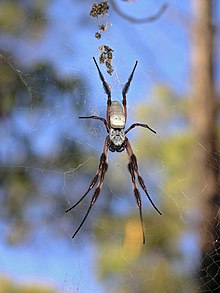
Orb-weaver spiders are members of the spider family Araneidae. They are the most common group of builders of spiral wheel-shaped webs often found in gardens, fields, and forests. The English word "orb" can mean "circular", hence the English name of the group. Araneids have eight similar eyes, hairy or spiny legs, and no stridulating organs.

Nephila is a genus of araneomorph spiders noted for the impressive webs they weave. Nephila consists of numerous species found in warmer regions around the world, although some species formerly included in the genus have been moved to Trichonephila. They are commonly called golden silk orb-weavers, golden orb-weavers, giant wood spiders, or banana spiders.

Trichonephila inaurata, synonym Nephila inaurata, commonly known as the red-legged golden orb-weaver spider or red-legged nephila, is a species of spider of the genus Trichonephila. It is native to southern and East Africa, as well as several islands of the western Indian Ocean.

Trichonephila clavata, also known as the Joro spider (ジョロウグモ , is a member of the Trichonephila genus. The spider can be found throughout Japan, Korea, Taiwan, China. As of October 2022, T. clavata's range spans at least 120,000 km2, occurring across Georgia, South Carolina, North Carolina, and Tennessee, with additional reports in Alabama, Maryland, Oklahoma, and West Virginia. Its pattern of spread suggests it is primarily driven by natural dispersal mechanisms, such as ballooning, though human-mediated transport cannot be discounted. Due to its large size and the bright, unique colors of the female Trichonephila, the spider is well-favored in Japan.

Trichonephila clavipes, commonly known as the golden silk orb-weaver, golden silk spider, or banana spider, is an orb-weaving spider species which inhabits forests and wooded areas ranging from the southern US to Argentina. It is indigenous to both continental North and South America. Known for the golden color of their silk, the large size of their females, and their distinctive red-brown and yellow coloring, T. clavipes construct large, asymmetrical circular webs attached to trees and low shrubs in woods to catch small- and medium-size flying prey, mostly insects. They are excellent web-builders, producing and utilizing seven different types of silk, and they subdue their prey by injecting them with venom, as opposed to related species which immobilize their prey by wrapping them in silk first. They are not known to be aggressive towards humans, only biting out of self-defense if touched, and their relatively harmless venom has a low toxicity, posing little health concern to healthy human adults. Due to their prevalence in forests, T. clavipes may be encountered by hikers.

Nephila pilipes is a species of golden orb-web spider. It resides all over countries in East and Southeast Asia as well as Oceania. It is commonly found in primary and secondary forests and gardens. Females are large and grow to a body size of 30–50 mm, with males growing to 5–6 mm. It is the second largest of the orb-weaving spiders apart from the recently discovered Nephila komaci. The first, second, and fourth pairs of legs of juvenile females have dense hairy brushes, but these brushes disappear as the spider matures.
Nephilengys is a genus of tropical spiders of the family Nephilidae, consisting of two currently described species. The genus Nephilingis has been split off from this genus. Both genera have been called hermit spiders from the habit staying in their retreats during the day; the name eunuch spiders has been used for Nephilengys alone. Males may sever parts of their palpal bulbs after copulation.

Trichonephila plumipes, the Pacific golden orb weaver, is a species of spider found in Australia, Indonesia and some Pacific Islands, which exhibits extreme sexual dimorphism through its sexual cannibalism behavior. It is sometimes called the tiger spider due to its markings which look similar to a tiger. This species was formerly called Nephila plumipes. As with other spiders from the genus Nephila, these spiders have a distinct golden web.
Relation du Voyage à la Recherche de la Pérouse is an 1800 book that gives an account of the 1791-1793 d'Entrecasteaux expedition to Australasia. The title refers to the search for La Pérouse, who disappeared in the region in 1788, a popular, though unsuccessful, object of the mission. Many of the discoveries made by the scientists attached to the expedition were published in the two volumes. The author, Jacques Labillardière, was a French botanist on the voyage, engaged to collect and describe the flora of the continent. The work includes some of the earliest descriptions of Australian flora and fauna, and an account of the indigenous peoples of Tasmania.

Phonognatha is a genus of South Pacific orb-weaver spiders first described by Eugène Simon in 1895. It was originally placed with the long-jawed orb weavers, and was moved to Araneidae in 2008.

Nephila komaci is a species of golden orb-web spider. It is the largest web-spinning spider known. A few specimens have been found in South Africa and Madagascar.
Edulis, edible in Latin, is a species name present in a number of Latin species names:

Mongolarachne is an extinct genus of spiders placed in the monogeneric family Mongolarachnidae. The genus contains only one species, Mongolarachne jurassica, described in 2013, which is presently the largest fossilized spider on record. The type species was originally described as Nephila jurassica and placed in the living genus Nephila which contains the golden silk orb-weavers.

Herennia multipuncta, commonly known as the ornamental tree trunk spider, is a species of spider in the family Nephilidae native to Asia. It exhibits sexual dimorphism, the female being much larger than the male. It weaves a small web on the trunk of a tree or the wall of a building and is well camouflaged by its dappled colouration.

Nephilingis is a genus of spiders in the family Nephilidae. It was split off from the genus Nephilengys in 2006. Both genera have been called hermit spiders from the habit of staying in their retreats during the day; alternatively the name "hermit spider" may be reserved for Nephilingis, with Nephilengys species called "eunuch spiders".

Nephilidae is a spider family commonly referred to as golden orb-weavers. The various genera in Nephilidae were formerly placed in Tetragnathidae and Araneidae. All nephilid genera partially renew their webs.
Artifex is a small genus of orb-weaver spiders native to tropical regions of mainland Australia and to New Caledonia. The genus was erected by R. J. Kallal and Gustavo Hormiga in 2018 to contain two species moved from different genera that have several synapomorphies, including an abdomen that extends past the spinnerets, widely separated spermathecae, and dorsal markings similar to those of Zygiellinae. The name is a combination of the Latin "ars", meaning "art", and "-fex", meaning "maker" in reference to the shelters they build out of leaves.

Trichonephila is a genus of golden orb-weaver spiders that was first described by Friedrich Dahl in 1911, as a subgenus of Nephila. Trichonephila was elevated to the level of genus by Kuntner et al. in 2019. The genus Trichonephila belongs to the Nephilidae family.

Argyrodes antipodianus, also known as the dew drop spider, is a species of kleptoparasitic spider from the cobweb spider family found in Australia, New Zealand and New Caledonia.
Some arachnids may be used for human consumption, either whole or as an ingredient in processed food products such as cheese (Milbenkäse). Arachnids include spiders, scorpions, and mites.






















